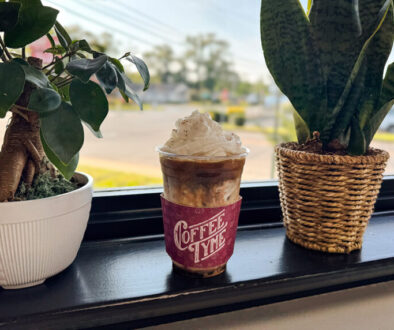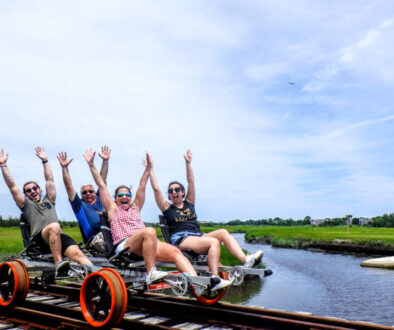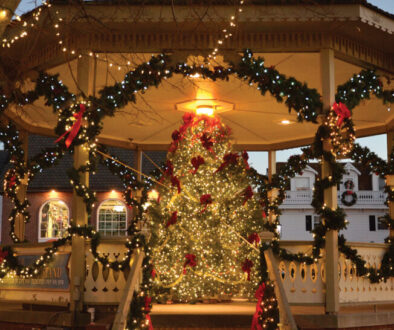Strutting by the Sea
Mummer Magic in the West Cape May Community Christmas Parade
The holidays begin in Cape May when the golden music from the Mummers string bands fills the sea air at the West Cape May Community Christmas Parade, now in its 55th year. There aren’t many towns that can claim entertainers such as these bands of merriment, strutting in their sequined, glittered, and feathered costumes. Among the blare of fire engines, marching bands, and dance troupes, their distinctive melody stands out.

On display in the Mummers Museum in Philadelphia is the following: “A Mummer is a person who masquerades with a mask. The German translation of mummer is mask and mumme for disguise, along with mummenkleid, meaning fancy dress, and mummenspiel as masquerade.”
The String Band Division is an integral part of the Mummers organization, based in Philadelphia. There are 15 string bands, eight composed of males and females, with approximately 55 members to a band. When attending fund-raising events, the band may decrease to 12 members or less.
The Mummers organization consists of 40 clubs, separated into five divisions, as follows: Fancy, Wench Brigade (don’t blame me, I’m just the messenger), Comic, String Band, and Fancy Brigade.
In 1901, the first official Mummers Day Parade began in Philadelphia. A newly formed string band participated that day featuring banjos, violins, and guitars. String Bands continued to grow, forming separate clubs, and in 1915 the clubs branched off into their own division. They used drums, saxophones, and accordions along with banjos, violins, and percussion instruments, including glockenspiels and bass violins—no brass instruments permitted.
Even today, the self-taught bands use the same instruments. In the Philadelphia Mummers Parade, some of the current band names are Avalon, Aqua, Duffy, Fralinger, Jersey String, Quaker City. They are the soul of the Mummers parade.
The Mummers’ roots can be traced to the Middle Ages, beginning with the Mummers play, an all-male cast, that was performed on the streets, a much-needed distraction for the underprivileged. The amateur performers wore large masks and acted out in silence, embracing the art of pantomime. It evolved into the “Mummers” parading through the streets, often entering different houses to perform a skit. In one popular skit the group gathered around a table and played dice, silently. This seemed enough to give anyone the shivers, but the homeowners found it quite entertaining. If drink or food were available, they’d gladly share it with the intruders.
A popular poem graces the wall at the Philadelphia Mummers Museum.
“HERE WE STAND BEFORE YOUR DOOR, AS WE STOOD THE YEAR BEFORE;
GIVE US WHISKY, GIVE US GIN, OPEN THE DOOR AND LET US IN.
OR BETTER GIVE US SOMETHING HOT. A STEAMING BOWL OF PEPPER POT.”
Philadelphia residents open their homes on New Year’s Day for any Mummer in need of a drink or snack to this day, as they have always done. Think of it as “a grab and go,” as the merrymakers continue along the parade route.
The first European colonists in the Philadelphia area brought with them many of their customs. One was to visit their neighbors on “Second Day Christmas,” December 26. Not long after, it was extended through New Year’s Day with boisterous folks wearing costumes parading through Center City. These entertainers soon formed different groups and in the mid-17th century began the first official parade. It combined elements from Swedish, Finnish, Irish, English, German, and other European heritages, as well as African traditions.
In the 1800s, German immigrants made their homes in Philadelphia bringing with them their Christmas traditions including an unseemly, masked character, the Beisnickle. He was the extreme opposite of our Santa Claus. Rather a curmudgeon, a disheveled man clad in fur, he visited children’s homes to assess their behavior over the past year. He’d carry a switch to use on the troublemakers and in his pockets, for the well-behaved children, were cakes and treats. Sometimes he’s portrayed in a beastly mask with a long tongue protruding through—enough to give even adults a nightmare or two. I can’t imagine what this image would do to a child! It’s believed that he had a profound influence on the Mummers costume and mask design.
Each year a new theme is developed that includes the music selection, the drill formation, and the costume. Themes are submitted by Valentine’s Day for approval by the Philadelphia String Band Association (PSBA). This ensures that another band hasn’t submitted the same theme for their four-and-a-half-minute performance at the Philadelphia Mummers Parade. Never have the themes and costumes been repeated since the parade’s inception in 1901.

The elaborate costuming for the Mummers begins with a theme tune and a conceptual design. Then it’s handed off to the designers who perform their magic tricks. The outcome is a one-of-a-kind creation which is then given to the professional costumers. After they have completed their work, the club members create the back pieces.
Design sketches decorate the museum’s walls including earlier works by the cherished designer, Bob Finnegan, once a department store display merchandiser, now deceased. His conceptual art and costumes live on, many decorated with feathers, brocade, velvet, satin, and metal framing.
The feathers used then and even today are obtained from the South African male ostrich, raised on farms for just this purpose. However, they aren’t inexpensive. A package of a dozen 24-inch feathers can cost $64.00, with many costumes requiring up to 20 packages. Often the feathers are saved and recycled for next year’s costumes. Among other feathers used are roosters and geese.
Besides feathers and sequins, LEDs have been added as costume designs became progressively more elaborate. And the glitter! Many string bands use pounds of glitter on their costumes. Yet, gluing the glitter, sequins and feathers on a costume can make it mighty heavy. And if that’s not enough, then everything is attached to a plywood frame, which can cause the weight of the costume to exceed 140 pounds! On occasion, the band’s captain takes on this endeavor but usually this is reserved for the Fancy Brigades, which perform a Broadway-type stage presentation rather than participate in the parade.


Each String Band will be led by their Captain, whose attire often exceeds the performers. Usually, he doesn’t carry an instrument, but wears a lavish costume, strutting in front as he leads his string band, arms pumping high in the air as he weaves side to side while engaging the audience in the performance. It’s hard to not be caught up in the party and not break into dance as the music passes you by.
To complicate matters for the string bands, the captain and seldom the band members, perform the “Mummers strut.” Because the costumes grew larger and more complicated, the “strut” is reserved to the string band’s captain.
The strut is seldom straight, as it takes on a life of its own. It’s difficult to compare the strut to one specific dance. It’s a combination of forward and backward steps, then a full turn when appropriate. The band captain moves with an arched back and then leans forward, then back, then repeats this dance pattern with an occasional zigzag. When you add in heavy costuming, it is nothing short of amazing.
String bands embrace the tradition of professionalism and are the soul of the parade. As they march through town, seldom missing a beat, you can’t help but appreciate what you’re witnessing as a true work of art.

The string band members are to be admired for their diligence in showmanship and the production of their cohesive, lively sound—considering that they are self-taught musicians—making their music appear effortless. This feat is accomplished through hard, time-consuming practice done repeatedly until it becomes perfection.
At the West Cape May Community Christmas Parade there will be performances by some of the Mummers string bands—Fralinger, Durning, and Jersey String, along with others. Their toe-tapping music will fill the brisk air and their sparkling costumes will light up the sky as they march past the crowds.
Jersey String’s Captain, Pat Walton, describes why they perform: “We do it to see the smiles on faces, young and old. And lastly it is all about having fun!” He is the face of the organization, engaging the crowd and leading the Jersey String band through town. You can tell by the smile on Pat’s face that he’s part of a greater calling, strutting to and fro, bringing his band of merriment to the streets, wanting nothing more than to bring the crowd joy. As Pat puts it, “Even if someone had a bad day, or is sick or disabled, just to see the pure joy on their faces when they pass by is like no other. Knowing that their band brought these bystanders, if only for a moment such joy, is priceless.”

The Jersey String members, like other Mummers—the box store clerks, salespeople, schoolteachers and more—come from all walks of life. In fact, this particular band has three generations on the street, either playing instruments, dancing, or leading the parade. In Pat’s family alone, are his father and brothers, strumming on banjos, along with his children, all ages, playing various instruments while others dance. Yet it isn’t just generations that are part of the band, but friends and neighbors joining the group to become one big family.
They meet weekly throughout the year and perform for weddings, private parties, and even for the Philadelphia Phillies baseball team. The bands begin working on their approved concept and theme the moment after New Year’s Day and don’t stop.


Art takes on many forms but any person or group who performs for the public, be it on stage or on the streets, should be viewed as more than just “entertainers.” The costuming, the music, the dance, meld together. For this alone, I praise the mastery of “mummery” and never want to see the creativeness and dedication to their art disappear but continue to evolve.
So, let’s give a shout out for “blue collar” art. And yes, it is and always will be a competition between the groups, vying for the ultimate prize. Yet many do it for the community and without much compensation for their sacrifices all year.
The Jersey String Band’s theme and costumes for this year’s West Cape May parade will be the same as when they competed in the 2022 Philadelphia Mummers Parade— “Jersey’s Shore Glad To Sea You,” performing tunes like “On The Way to Cape May, “Wildwood Days,” and more, while wearing old-fashioned bathing garb—and other surprises. Seems a bit minimalist attire for the winter but keep in mind that the Mummers perform on New Year’s Day and must adapt to the Northeast’s cold weather. That said, the string bands that perform in December for the West Cape May Community Christmas Parade often endure the cold air and a snow flurry or two. Who is to say what temperature will be that day; a balmy 70 or a frigid 15 degrees? And the string bands must keep in step with the marching bands, dance troupes, and the floats pulled by pickup trucks, not to mention the fire engines.

How lucky are the visitors who attend the annual West Cape May Community Christmas parade to witness the Mummer magic? To the first timers visiting our town and to seasoned attendees, welcome back, and join in on the sidelines with a shout out and perhaps add a bit of quick stepping to welcome the Mummers as they pass you by. ■
The Mummers Museum in Philadelphia has a wealth of information on both its history and future. It is chock full of costumes and detailed design sketches that have been used in the past, along with a myriad of artifacts, including original instruments. If you visit Philadelphia, consider this a “must see.”
The West Cape May Community Christmas Parade is on December 3, 2022, beginning at 5pm from the West Cape May Volunteer Firehouse.



